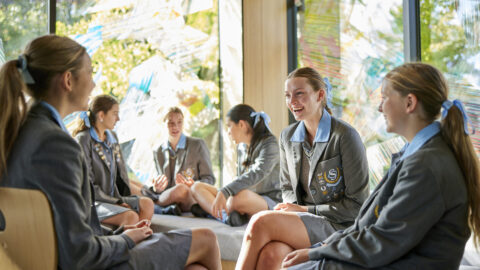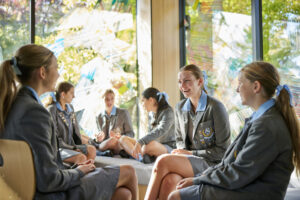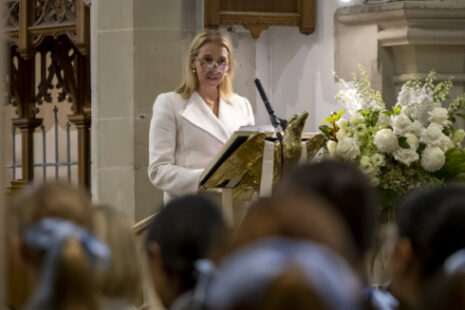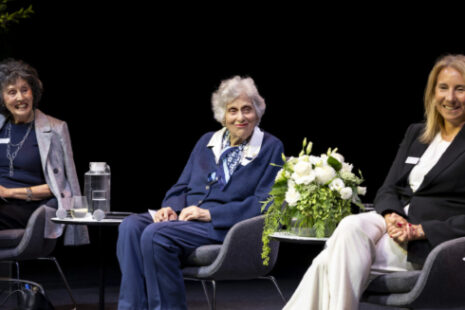The Classroom Culture of Girls Schools

We have continued to enjoy the leadership of Mr Rob Marshall in our School this year, working alongside staff across both our Barbreck Junior School and Senior School, and drawing on his capacity as Researcher in Residence at St Catherine’s. In addition to this he enjoyed a small but successful period as the Acting Head of Year 10 in Term 1. A month of work that he described as one of his most professionally fulfilling roles.
Mr Marshall is also working two days a week as the Research Manager: International Coalition of Girls’ Schools.
On 22 March 2023, the previously titled Alliance of Girls’ Schools member schools voted unanimously to merge with the International Coalition of Girls Schools (ICGS). The merger unites the Alliance’s 185 member schools across Australia and New Zealand with ICGS’s membership. Bringing together over 550 girls’ schools across 21 countries representing over 350,000 students globally.
Our current Year 9 Exchange Schools in the UK (St Catherine’s Bramley, St George’s Ascot and Royal Girls High, Bath) the USA (Buffalo Seminary School) and Canada (Crofton House) are also members of the Coalition.
ICGS is the world’s leading voice for the education and empowerment of girls and young women. Together, they advocate and support the distinctive work of girls’ schools in their provision of unparalleled opportunities for girls. ICGS contributes to the development and promotion of education around the world and the empowerment of young women to reach their potential and become influential contributors to the complex and changing world.
In his two roles, Rob relishes the opportunity to think deeply about the latest issues arising for schools today and educating girls, which informs his research and writing. Some of the recent research emerging from the Coalition reveals:
Her Academic Success: higher confidence and better outcomes
 A groundbreaking Australian study, Hands Up For Gender Equality, found that girls educated in single-sex schools are equally as confident as boys educated in single-sex schools. In other words, the frequently reported gender difference in confidence levels between men and women in the workplace simply does not exist for girls educated in girls’ schools. This confidence has been shown to be critical to academic and life success.1
A groundbreaking Australian study, Hands Up For Gender Equality, found that girls educated in single-sex schools are equally as confident as boys educated in single-sex schools. In other words, the frequently reported gender difference in confidence levels between men and women in the workplace simply does not exist for girls educated in girls’ schools. This confidence has been shown to be critical to academic and life success.1
It also begs the question: Is it mixed-sex environments that contribute to girls’ and Women’s lower levels of confidence?
An analysis of the OECD’s Programme for International Student Assessment (PISA) results shows that girls from girls’ schools in Australia and New Zealand outperformed girls from co-educational schools on all academic measures of Science, Mathematics, and Literacy.2
Several Australian studies also demonstrate that girls in single-sex schools are more confident in Mathematics in junior secondary and more likely to take advanced Science and Mathematics subjects in senior secondary than girls in co-ed schools.3
Her Career: no limits to what she can achieve
Enjoyment of Science and Mathematics subjects and activities like coding and robotics inspire girls to pursue careers in STEMM (science, technology, engineering, maths and medicine). Graduates of girls’ schools in Australia and New Zealand are significantly more likely to enter male-dominated fields like engineering and construction than girls from co-ed schools.4
A study of nearly 6,000 incoming female university students found that graduates of all-girl schools are more likely to show higher levels of science self-confidence, consider themselves critical thinkers, score higher on measures of academic habits of mind, and demonstrate stronger study habits.5
Her Safety: there’s less bullying and greater respect
The incidence of bullying for girls in single-sex schools is markedly lower than for girls in co-educational schools across all six of PISA’s measures of bullying — including being made fun of, being the subject of nasty rumours, and being pushed or hit — with a difference of up to 11 percentage points.10
 Research has found less aggressive behaviours in girls’ schools than in boys’ and co-educational schools.11 While many girls report preferring girls-only Science, Computing and IT classes where they are not subject to stereotyped beliefs and bullying by boys.12 Similarly for Physical Education (PE) classes and sporting activities, international research shows that a large majority of girls strongly prefer all-female PE classes and sports where they are not self-conscious of their body image and what they are wearing. They do not have to take part in competitive mixed-gender activities which reinforce existing stereotypes and undermine girls’ enjoyment of physical exercise which is so important to their long-term physical and mental health.13
Research has found less aggressive behaviours in girls’ schools than in boys’ and co-educational schools.11 While many girls report preferring girls-only Science, Computing and IT classes where they are not subject to stereotyped beliefs and bullying by boys.12 Similarly for Physical Education (PE) classes and sporting activities, international research shows that a large majority of girls strongly prefer all-female PE classes and sports where they are not self-conscious of their body image and what they are wearing. They do not have to take part in competitive mixed-gender activities which reinforce existing stereotypes and undermine girls’ enjoyment of physical exercise which is so important to their long-term physical and mental health.13
Mr Marshall’s latest research looks at a report published by the OECD about the steady decline of Australian education as evidence in the PISA performance results. Yet further analysis of the PISA data suggests unequivocally that “girls’ schools provide distinct advantages over co-educational schools.”
In addition to girls’ schools scoring up to 10 percentage points higher on PISA’s 2015 and 2018 academic tests of Science, Mathematics and reading, the Coalition Report showed girls’ schools have better conditions for learning. The Report says “Single-sex school students are more likely than co-educated girls to report experiencing learning environments in which they are able to fulfill their learning goals due to substantially lower amounts of disruption or distraction.”
The findings from this research endeavoured to shed light on the potential benefits of single-sex education in terms of fostering conducive learning environments. The study found that single-sex school students report lower levels of disruption and distraction compared to co-educated girls, leading to a greater ability to fulfill their learning goals. Teachers at St Catherine’s proudly foster a learning culture that minimises distractions and focuses on building purposeful learning environments for every class, every day.
Mr Marshall’s full article can be read below. In this issue of The Blue Ribbon, Rob also shares insights into the teaching and learning culture of our Junior School in his research article Outstanding Results for Barbreck available to read here.
♦
AGSA eBrief: Issue 6/2023: April 26
Girls’ Schools classrooms are less disruptive.
The OECD recently published a report Education Policy Outlook in Australia (OECD, 2023) providing a less than satisfactory commentary on Australian education. While observing that Australia continues to perform at or above OECD average in PISA, performance has been in steady decline across reading, Mathematics and Science. However, the disciplinary climate in schools in Australia was among the least favourable in the OECD according to students’ reports in PISA 2018.
 Glenn Fahey, Program Director in Education Policy at the Centre for Independent Studies said the “OECD has handed down yet another disappointing report card on Australia’s school systems. It shows record spending has been paralleled by declining outcomes for both students and teachers. Importantly, the report makes clear a common denominator to school systems’ problems is the increasing disruption and disorder in classrooms. Australia ranks 70th out of 77 on the “disciplinary climate index” – placing it among the least orderly in the world.”
Glenn Fahey, Program Director in Education Policy at the Centre for Independent Studies said the “OECD has handed down yet another disappointing report card on Australia’s school systems. It shows record spending has been paralleled by declining outcomes for both students and teachers. Importantly, the report makes clear a common denominator to school systems’ problems is the increasing disruption and disorder in classrooms. Australia ranks 70th out of 77 on the “disciplinary climate index” – placing it among the least orderly in the world.”
The 2020 AGSA report The Girls School Edge: A comparison of outcomes for girls from single-sex and co-educational schools using PISA data from 2015 and 2018, provides strong support for the value of an all-girls schooling environment and adds to the growing body of international research that shows unequivocally that girls’ schools provide distinct advantages over co-educational schools. In addition to girls’ schools scoring up to 10 percentage points higher on PISA’s 2015 and 2018 academic tests of Science, Mathematics and reading, the AGSA report showed girls’ schools have better conditions for learning. The report says “Single-sex school students are more likely than co-educated girls to report experiencing learning environments in which they are able to fulfill their learning goals due to substantially lower amounts of disruption or distraction.”
- A greater proportion of students attending girls’ schools never or almost never experience an English classroom in which they cannot work well compared with girls in co-educational schools (43% to 31%).
- More students attending girls’ schools stated they are never or almost never in a Science classroom where they cannot work well (41% to 29%).
- Girls at single-sex schools are also less likely to have to wait for their teacher to quiet the class before teaching (33% to 22%).
Effective teachers and school leaders know that successful learning in the classroom is based on the development of a culture characterised by high expectations, provision of clarity about what teachers are to teach and students are to learn, establish strong professional learning communities and leading ongoing efforts to improve teaching practices.
The Australian Council for Educational Research (ACER) developed the National School Improvement Tool (NSIT) which brings together findings from international research into the practices of highly effective schools and school leaders. The NSIT outlines nine distinct domains which high performing schools demonstrate consistently. The third domain, a Culture that promotes learning, states that, effective and high performing schools have “clear strategies to promote appropriate behaviour – including agreed responses and consequences for inappropriate student behaviour – and the school provides sufficient support for teachers to implement these policies.” (Masters, 2016) In addition, “classrooms are calm but busy and interruptions to teaching time are kept to a minimum. There are no obvious behavioural problems, very high rates of school attendance and engagement, and staff morale is sustained at a high level.” Effective student learning requires a classroom culture which is not disruptive and permits students to participate without undue distraction or inhibition.
Monash University academic Erin Leif commented on the OECD report regarding the issue of class disruption, that the survey suggests Australian students perceive their classrooms to be more disruptive than they have in the past. It also implies one of the reasons teachers are choosing to leave the profession is disruptive behaviour. Leif adds that “post-COVID, teachers have reported student behaviour appears to be getting worse, with students more distracted and less engaged than before the pandemic began.” In girls’ schools, the research evidence strongly supports a more positive and less disruptive environment than co-educational schools.
There are several reasons why girls-only classes may be less disruptive than co-educational classes.
- Reduced gender stereotypes and expectations: In co-educational classes, students may be more likely to conform to gender stereotypes, such as boys being rowdy and disruptive, and girls being quiet and studious. In girls-only classes, these expectations are reduced, allowing students to focus on their learning without the pressure to conform to gender norms.
- Improved confidence and self-esteem: Research has shown that girls may be more likely to participate in class and take risks in a single-sex environment. This is because they may feel more comfortable speaking up and expressing themselves without fear of judgment or ridicule from their male peers.
- Reduced competition for attention: In co-educational classes, boys may dominate classroom discussions and activities, leaving girls with less opportunity to participate and contribute. In girls-only classes, girls have equal access to the teacher’s attention and are more likely to take an active role in the learning process.
- Increased motivation: Girls-only classes may provide a more supportive and collaborative environment, which can increase motivation and engagement in learning. Girls may be more willing to take on challenges and work collaboratively with their peers without feeling judged or overshadowed by male classmates.
- Reduced sexual harassment: In co-educational classes, girls may experience sexual harassment and unwanted attention from male classmates. This can be distracting and disruptive to their learning. In girls-only classes, girls are free from this type of harassment and can focus on their studies without fear of being objectified or harassed.
- Improved academic performance: Research has shown that girls may perform better academically in single-sex environments. This may be due to reduced distractions, increased participation, and improved self-esteem and confidence.
While the OECD report provides interesting commentary on Australia’s education system, it is the underlying classroom culture of girls’ schools that provides a point of difference in educational outcomes.
Article written by Mr Robert Marshall, St Catherine’s School Researcher in Residence and Research Manager: International Coalition of Girls’ Schools.





